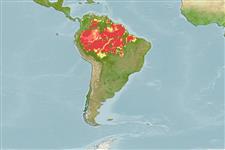Classification / Names
आम नाम | उपशब्द | Catalog of Fishes (gen., sp.) | ITIS | CoL | WoRMS | Cloffa
ऐकटीनोप्टीरेजी (रेज़-फिन्नढ मछलियाँ) >
Gymnotiformes (Knifefishes) >
Gymnotidae (Naked-back knifefishes)
Etymology: Electrophorus: Greek, elektron = amber + Greek,pherein = to carry (Ref. 45335).
पर्यावरण / जलवायु / सीमा
पारिस्थितिकी
; स्वच्छ जल, अलवण जल बेनथोपिलाजिक. Tropical; 23°C - 28°C (Ref. 1672), preferred ?
South America: Amazon and Orinoco River basins, and related areas in northern South America.
आकार / वज़न / Age
Maturity: Lm ? range ? - ? cm
Max length : 250 cm SL पुल्लिंग / अलिंग; (Ref. 27188); अधिकतम प्रकाशित वज़न: 20.0 kg (Ref. 27188)
Short description
आकृति विज्ञान | मौरफोमैटरिक्स
पृष्ठीय रीढ़ (सम्पूर्ण): 0; पृष्ठीय सौफट रेज़ (सम्पूर्ण): 0. Body elongated and cylindrical, almost without scales; head flattened; mouth large with one row of conical teeth on each jaw; presence of three abdominal pairs of electric organs; body color dark with anterior ventral part yellowish (Ref. 12225).
Prefer muddy bottoms and calm waters; frequently found in coastal plains, swamps and creeks but is also found inland where a favorable biotope exist. Juveniles feed on invertebrates, adults feed on fish and small mammals (Ref. 12225), first-born larvae prey on other eggs and embryos coming from late spawning batches (Ref. 40645). The electric organ of this species consists of flattened electrocytes, numbering to about hundreds of thousands, connected in series (Ref. 10840; 10011). Generates two type of electric organ discharges (EODs) from different electric organs which are of myogenic derivation: 1) low-voltage EODs (about 10 V) emitted by the Sach's organ at rates of up to 25 Hz, and 2) high-voltage EODs (about 50-fold) emitted by the main and Hunter's organs at peak rates of up to several hundred Hz. Low-voltage EOD has been associated with electro location whereas high-voltage EOD has been noted during predatory attacks (Ref. 10011). An EOD of 500 V was recorded from a 1 m specimen (Ref. 10530), making it a potentially dangerous species. Incorporation of this species in fish-based house security systems has been suggested (see Ref. 9506). Also possesses high-frequency sensitive tuberous receptors patchily distributed over the body that seems useful for hunting other gymnotiforms (Ref. 10583). A nocturnal species; captive specimens showed higher low-voltage EOD activity during the night compared to daytime (Ref. 10011). This cycle seems to be free-running (internally controlled) (Ref. 10829). Probably a fractional spawner; fecundity count was17,000 eggs (Ref. 10630). An obligatory air breather (Ref. 10011) and can withstand poorly oxygenated water (Ref. 26457). Used in experimental studies.
Males construct foam nests and guard the growing larvae until mid-January when the first seasonal rains flood the breeding area, causing the about 10 cm long young eels to disperse (Ref. 40645).
Males outnumber females (3:1) and are considerably larger than females (Ref. 40645).
There are three successive batches of eggs deposited in a spawning period. Not all eels with fully developed gonads (in Goiapi drainnage) participated in the annual spawning activity suggesting that mating success depends in part on finding suitable breeding sites (Ref. 40645).
Ortega, H. and R.P. Vari, 1986. Annotated checklist of the freshwater fishes of Peru. Smithson. Contrib. Zool. (437):1-25. (Ref. 6329)
IUCN Red List Status (Ref. 115185)
CITES (Ref. 94142)
Not Evaluated
Human uses
मात्स्यिकी: व्यापारिक; जलजीवालय: सार्वजनिक लजीवालय
अधिक जानकारी
संदर्भजलीयकृषिजलीयकृषि रूपरेखाखींचआनुवंशिकीऐल्लि आवृतियाँहैरेटिबिलटीबीमारीप्रक्रमणMass conversion
साधन
Special reports
Download XML
इंटरनेट स्रोत
